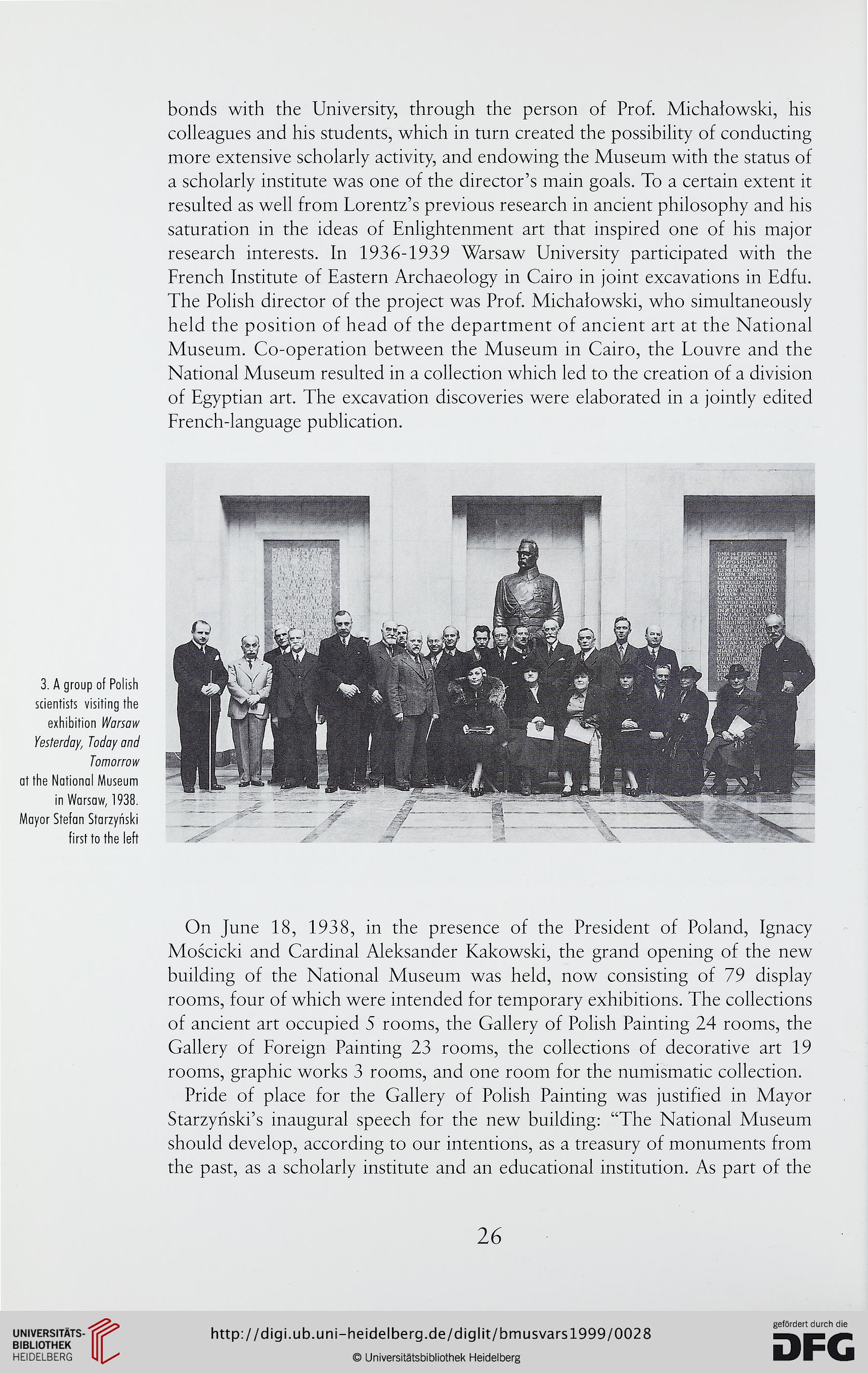bonds with the University, through the person of Prof. Michałowski, his
colleagues and his students, which in turn created the possibility of conducting
morę extensive scholarly activity, and endowing the Museum with the status of
a scholarly institute was one of the director’s main goals. To a certain extent it
resulted as well from Lorentz’s previous research in ancient philosophy and his
saturation in the ideas of Enlightenment art that inspired one of his major
research mterests. In 1936-1939 Warsaw University participated with the
French Institute of Eastern Archaeology in Cairo in joint excavations in Edfu.
The Polish director of the project was Prof. Michałowski, who simultaneously
held the position of head of the department of ancient art at the National
Museum. Co-operation between the Museum in Cairo, the Touvre and the
National Museum resulted in a collection which led to the creation of a division
of Egyptian art. The excavation discoveries were elaborated in a jointly edited
French-language publication.
3. A group of Polish
scientists visiting the
exhibition Warsaw
Yesterday, Today and
Tomorrow
at the National Museum
in Warsaw, 1938.
Mayor Stefan Starzyński
first to the left
On June 18, 1938, in the presence of the President of Poland, Ignacy
Mościcki and Cardinal Aleksander Kakowski, the grand opening of the new
huilding of the National Museum was held, now consisting of 79 display
rooms, four of which were intended for temporary exhibitions. The collections
of ancient art occupied 5 rooms, the Gallery of Polish Painting 24 rooms, the
Gallery of Foreign Painting 23 rooms, the collections of decorative art 19
rooms, graphic works 3 rooms, and one room for the numismatic collection.
Pride of place for the Gallery of Polish Painting was justified in Mayor
Starzyńskie inaugural speech for the new huilding: “The National Museum
should develop, according to our intentions, as a treasury of monuments from
the past, as a scholarly institute and an educational institution. As part of the
26
colleagues and his students, which in turn created the possibility of conducting
morę extensive scholarly activity, and endowing the Museum with the status of
a scholarly institute was one of the director’s main goals. To a certain extent it
resulted as well from Lorentz’s previous research in ancient philosophy and his
saturation in the ideas of Enlightenment art that inspired one of his major
research mterests. In 1936-1939 Warsaw University participated with the
French Institute of Eastern Archaeology in Cairo in joint excavations in Edfu.
The Polish director of the project was Prof. Michałowski, who simultaneously
held the position of head of the department of ancient art at the National
Museum. Co-operation between the Museum in Cairo, the Touvre and the
National Museum resulted in a collection which led to the creation of a division
of Egyptian art. The excavation discoveries were elaborated in a jointly edited
French-language publication.
3. A group of Polish
scientists visiting the
exhibition Warsaw
Yesterday, Today and
Tomorrow
at the National Museum
in Warsaw, 1938.
Mayor Stefan Starzyński
first to the left
On June 18, 1938, in the presence of the President of Poland, Ignacy
Mościcki and Cardinal Aleksander Kakowski, the grand opening of the new
huilding of the National Museum was held, now consisting of 79 display
rooms, four of which were intended for temporary exhibitions. The collections
of ancient art occupied 5 rooms, the Gallery of Polish Painting 24 rooms, the
Gallery of Foreign Painting 23 rooms, the collections of decorative art 19
rooms, graphic works 3 rooms, and one room for the numismatic collection.
Pride of place for the Gallery of Polish Painting was justified in Mayor
Starzyńskie inaugural speech for the new huilding: “The National Museum
should develop, according to our intentions, as a treasury of monuments from
the past, as a scholarly institute and an educational institution. As part of the
26




